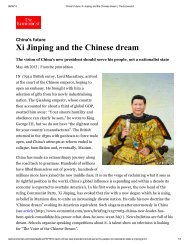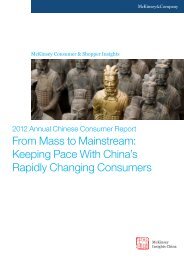You also want an ePaper? Increase the reach of your titles
YUMPU automatically turns print PDFs into web optimized ePapers that Google loves.
QIU Jing and LIN Ruiming|Figure 3 Male/Female Ratio by Age Group, 2003-20111.41.2Adolescents("Post-90s")Emerging Adults("Post-80s")Full Adults("Post-70s")1.00.80.60.40.20Aged 10~19Aged 20~29Aged 30~392003 2004 2005 2006 2007 2008 2009 2011Source: National Bureau of Statistics.1970s, the birth rate plunged from 33.4 percentin 1970 to 18.3 percent in 1978. Thereafter it remainedrelatively steady during the 1980s (between18 percent-24 percent), with 1987 (23.3percent) being the peak of the decade. In the1990s, China’s birth rate decreased again from19.6 percent in 1991 to 14.0 percent in 2000.The Post-90s generation (Adolescents) is less numerousthan the Post-80s generation (EmergingAdults), and both of these are smaller than thePost-70s generation (Full Adults). This meansthat the combined age group of people aged10-29 will continue to decrease, resulting in asmaller young consumer population from 2010to 2020.Another notable fact is the skewed male-tofemaleratio among younger people. UnlikeEmerging Adults (aged 20-29) and Full Adults(aged 30-39) which both have more females thanmales (M/F ratio < 1), Adolescents (aged 10-19)have a larger number of males. This means thatthe Post-90s generation has far more boys thangirls, and that the young consumer populationin China will be male dominated from 2010 to2020.key factors foryoung consumersMore Family WealthWhile both the Post-80s and Post-90s generationare mostly only children and hence the “littleemperors” 2 of their family, they differ substantiallyfrom each other in terms of parental/family wealth accumulation. To sum up, thePost-90s generation has brighter financial prospectsand a larger expenditure budget than thePost-80s generation due to their parents’ higheraccumulation of family wealth. In other words,as the younger generation gradually replacesthe older generation to become the mainstreamof Emerging Adults in China from 2010 to 2020,2 “Little emperors” refers to the phenomenon where parents lavish resources and attention on a single child, as a result of the one-childpolicy.January 2013 | SERI Quarterly | 25
New Trends among Young Chinese Consumers|Table 1 Comparisons of Parents of the Post-80s and Post-90s GenerationsParents of the Post-80s generationParents of the Post-90s generationGenerational identity Post-50s, or born in the 1950s Post-60s, or born in the 1960sEducationCareerDeprived of formal high-school or college educationduring the Cultural Revolution (1966-1976)Due to lack of education and skills, many had no choicebut to become low-income workers. Many were laid offand forced into early retirement in the late 1990s whenChina put forward SOE restructuring and reformsAble to complete college (or at least high school)education as the Cultural Revolution and its socialdisruptions had dissipated by the time they reachedadolescenceThey became the first-generation beneficiaries ofChina’s “Reform and Opening-up” Policy due toemerging market opportunities when they first joinedthe labor forceWealth accumulationand financialrelationships with theirchildrenInfluence on theirchildren’s consumptionbudgetNot having accumulated much family wealth, and withat best minimal pension funds, they cannot providemuch financial help to their Post-80s children, who facesoaring property prices and living costs after graduationin the 2000s. Many rely on their children financiallyThe Post-80s generation have become “propertyslaves” 3 due to their stringent budget constraints onspending and consumptionMany were able to purchase housing before propertyprices in China skyrocketed in the 2000s. Many actuallybenefited from soaring property prices as theirhomes rendered huge capital gains. Instead of actingas a financial burden, this generation serves as a hugefinancial resourceThe Post-90s generation has not yet entered society,but may not need to buy property in the future. Theyhave brighter financial prospects and a larger expenditurebudget than the Post-80s generationChinese young consumers will on average beable to spend more.Natural-Born Netizens & “Otaku”China entered the Internet Age in the late 1990sand early 2000s, when the eldest Post-90s childrenwere still in primary school. Unlike thePost-80s generation who needed time to learnand transition to an online world, the Post-90s generation grew up with the Internet frombirth, making them “natural-born netizens.”|Table 2 Internet Use in China for Those under 35Age12-18Teenagers19-25University Students26-35Young Professionals26-35Young SeekersBasics Grew up with the Internet Grew up with the Internet Educated and middle class Lower education and incomeMotivesFun and learningMaintaining socialconnectionsMaking work, life andplay easierExcitement and achievementUsageVideos and instantmessaging (IM)Willing to try new activitiesVideos, IM, and weibo 4 Wide usage across the board Videos, games, IM, ande-commerceSource: BCG 2011 survey of 2,000 consumers from first- to fourth-tier cities and rural areas.3 “Property slaves” refer to those who accumulated massive debt and relied on high financial leverage to purchase real estate.4 “Weibo” refers to microblogging services based in China.26 | www.seriquarterly.com
QIU Jing and LIN Ruiming|Table 3 Mobile Internet Use of the Post-80s and Post-90s GenerationsPost-80s generationPost-90s generationShare of population using mobile phones to access the Internet 34% 39%Average online duration of mobile phone use 49 minutes 57 minutesSource: GroupM Knowledge & Campus Marketing Institute (CMI) 2010 survey.The Post-90s generation has also been quickerto embrace the mobile Internet, as demonstratedby their longer online usage of mobilephones.Furthermore, since both these generations lacksiblings and have fewer neighborhood peers tosocialize with (both urban and rural communitiesin China have changed massively comparedto the last century), many among the Post-90sgeneration would rather stay at home than engagein outdoor activities. This has given riseto the labeling of the Post-90s generation as an“otaku” generation. 5 This generation’s onlinebackground, moreover, has caused it to trust socialnetworking sites (SNS) and weibo above othersources of information.Higher Legacy of UrbanizationThe Post-90s generation was also born andraised in an environment of accelerating urbanizationafter the mid-90s, as shown in the figurebelow. The older generation of peasant workers(i.e., the rural Post-60s and Post-70s generation)gave birth to new urban children (the Post-90s and Post-00s generation) in large cities, whileyounger-generation peasant workers themselves(i.e., the rural Post-90s generation) have themselvespoured into the cities to seek opportunity.Accordingly, in contrast to many rural Post-80schildren, the Post-90s generation has had accessto urban amenities nearly from birth. This backgroundhas had a significant impact on their socialidentities and consumption tendencies.|Figure 4 Perceptions of “Post-90s” College Students on Various Internet ApplicationsPossibility of Content Sharing (%)Comprehensiveonline forumsVideo websites SpecializedMagazinesonline forumsTV SearchE-commerceenginesBroadcastswebsitesSNSPortal websitesWeiboCredibility (%)Source: GroupM Knowledge & Campus Marketing Institute (CMI) 2010 survey.5 “Otaku” is a Japanese word that refers to persons who maintain an obsessive, often solitary interest in hobbies like animation, comics,video games, or electronics.January 2013 | SERI Quarterly | 27
New Trends among Young Chinese Consumers|Figure 5 Share for Urban Population in China, 1970-2010(%)60504030201001970 1975 1980 1985 1990 1995 2000 2005 2010Source: National Bureau of Statistics.The foregoing figure depicts the environmentand background wherein young Chinese consumershave grown up. China’s opening to theoutside world 30 years ago has given youngChinese vastly more opportunities than theirpredecessors to broaden their horizons and becomeexposed to different cultures. At the sametime, China’s one child policy has brought theseyounger consumers more comfortable financialprospects and larger budgets.Consumption trendsA Love Affair with BrandsLike their Western counterparts, Chinese judgethemselves and others by what they buy. Asmentioned earlier, this younger generation ofconsumers has grown up in a more open (andmore openly commercial) society, and hasbeen exposed early on to domestic and foreignbrands. It is thus quite natural for them to prefergoods with recognizable names.Young consumers are not only interested inpurchasing name brands, they also have themeans to do so. This is driven by the culturaland economic changes taking place in China.First, because of the one-child policy, parentscan and want to give their child financial support.Second, available credit and increased culturalacceptance of debt has led to increaseduse of credit cards and bank loans as fundingvehicles among the young.This is not only true among young consumerswho grew up in big cities with wealthy parents.It also holds true among the new generation ofmigrant workers who have come to the citiesfrom the countryside.The new generation of migrant workers numbersapproximately 100 million. This generationis the primary group that has helped breakdown the dual urban-rural structure and spedup urbanization in China. Compared with theprevious generation of migrant workers, thisnew generation has undergone a transformationin values and behavioral patterns.The new generation of rural migrant workersare losing their identities as farmers, despite beingborn into farming families in rural areas.28 | www.seriquarterly.com
QIU Jing and LIN RuimingLike the old generation of migrant workers,they work hard in cities with little pay and littleaccess to social welfare. However, these newmigrant workers are better educated than theirpredecessors and wish to become a part of thecities where they work. They try hard to keepup with the latest trends and desire to be “fashionicons” in their new urban homes.A typical young migrant worker may live in a5-square-meter basement apartment. Half ofhis room is occupied by the bed. When it rains,water may leak from the ceiling. Despite hispoor living conditions, this new migrant workerstill manages to buy a fancy wallet, a shinywatch, and a tablet computer, paid off by a newcredit card. The typical young migrant prioritizesbrand names far above living conditions.Desire for Self-Expression andDistinctivenessToday’s culture places much more emphasisand value on self-expression and individuality.The one-child policy also contributes to the desirefor distinctiveness. Compared with the oldergeneration, the young are less willing to formcliques and care more about their own independence,freedom and distinctiveness. The oldergenerations emphasize “us,” while the youngergenerations prize “me.” Young people in particularspend money to reflect their personal tastesand sensibilities. Emotional considerations, likewhether a product reflects the user’s sense of individuality,are paramount in their purchasingdecisions.Compared with the oldergeneration, the young areless willing to form cliquesand care more about theirown independence,freedom anddistinctiveness. The oldergenerations emphasize“us,” while the youngergenerations prize “me.”At the same time, niche brands are gainingground among young Chinese consumers. Although,major brands have had a monopoly onsuccess in China so far, young consumers tendto see purchases of mainstream big brands asgetting lost in a crowd. In response, they tend totry lesser known brands, seeing these purchas-January 2013 | SERI Quarterly | 29
New Trends among Young Chinese Consumerses as a way of setting themselves apart from thecrowd.More Attention toEnvironmental/Social ConcernsWith access to the latestdata, China's younggeneration has openedup to a broader vision ofthe world, and gainedmore access to theessence of humancivilization.Such changes haveinduced young consumersto pay much moreattention to environmentaland social concerns thanprevious generations.China’s young generation has long been describedas being a pampered lot without disciplineor drive. Fully exposed to commercial society,they are accustomed to a world in whichjunk food, the Internet, and other modern conveniencesare ubiquitous, while being seen as indifferentto the classical pursuits cherished bytheir forefathers.The reality is that China’s young generation isenjoying the benefits of 30 years of reform andopening up. Compared with their fathers’ generation,they are better educated and informed.With access to the latest data, they have openedup to a broader vision of the world, and gainedmore access to the essence of human civilization.Such changes have induced young consumersto pay much more attention to environmentaland social concerns than previousgenerations.Heavy Reliance on Online ShoppingThe younger generation has grown up with theInternet, and is used to shopping online.One recent phenomenon that has made wavesamong China’s young consumers is Tmall’s“Singles’ Day” promotional festival, which fallson November 11, or “11.11”—four singles. Thesale was initiated by e-commerce firm Alibaba,with Taobao.com and Tmall.com, and wasbased in Hangzhou, the capital of eastern ZhejiangProvince. Many of the merchants who soldtheir goods on Alibaba’s sites offered 50 percentdiscounts. Eight hours into the shopping festival,sales volume reached 5 billion yuan, closeto last year’s figure for the whole day of 5.2 bil-30 | www.seriquarterly.com
QIU Jing and LIN Ruiminglion yuan. After about 11 hours, sales reached7.9 billion yuan ($1.265 billion), topping the totalof $1.25 billion that US online retailers tookin last year on Cyber Monday (the day afterThanksgiving), when online merchants marktheir highest sales. After 24 hours, total volumereached 19.1 billion yuan. The note of triumphwas also echoed by Alipay.com, Alibaba’s paymentplatform, who announced it had completed105.8 million trades on a single day, a recordbreakingfigure both for itself and for paymentservices worldwide.ConclusionsChina economy is growing fast, and its marketis changing rapidly, as are its consumers.The Post- 90s’ young consumers have started tomake themselves felt in the consumer market,and will be playing a more and more importantrole.they have little experience with hardship andmore exposure to different cultures, they aremore optimistic, more open-minded and moreindividualistic, compared with previous generations.As a result, they love big brands, pursueself-expression in their purchases, immersethemselves in the digital world, and are interestedin environmental and social sustainability atthe same time.In order to win the market, companies need toprepare for the new generations of young consumers,and adjust their branding and marketingstrategies in line with the trends outlinedabove.KeywordsChina market, consumption trends, youngconsumers, Post-90s, brands, self-expressionAlthough these young consumers are not identical,they do share some characteristics. Because|Figure 6 Online Shopping Transaction Size/TotalRetail Sales of Social Consumer Goods4.26%2.98%2.10%0.24% 0.58%0.03%0.39%0.09%2003 2005 2007 2009 2011Source: National Bureau of Statistics.1.12%QIU Jing is a research fellow at SERI China. Her research focuseson China’s consumer markets and retail industries. Sheattained her Ph.D. in Organizational Management at Peking University.Contact:jingqiu.qiu@samsung.comLIN Ruiming is a research fellow at SERI China. His researchfocuses on opportunity recognition and competitive dynamics issuesin China’s emerging industries. He was a Ph.D. candidate inStrategic Management from London Business School. Contact:ruiming.lin@samsung.comJanuary 2013 | SERI Quarterly | 31





